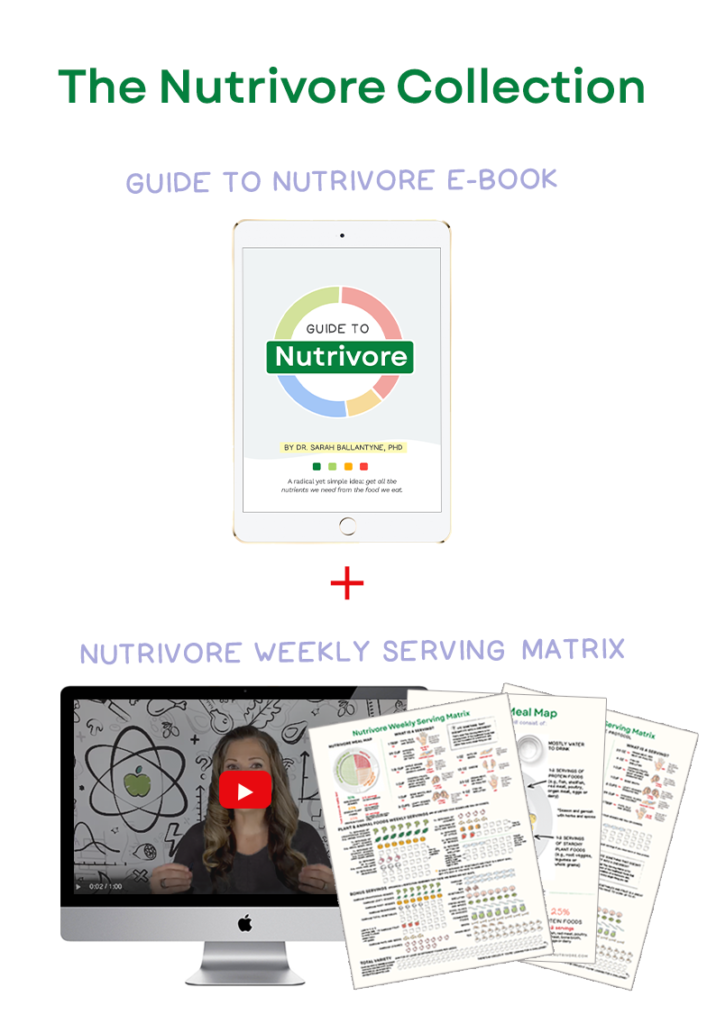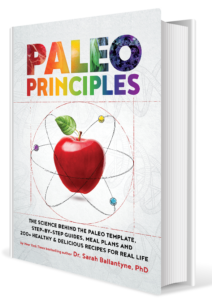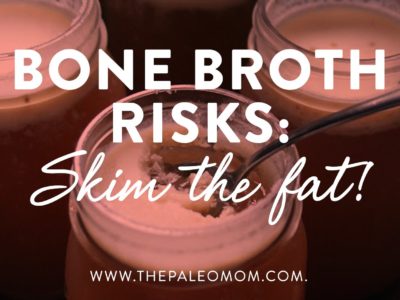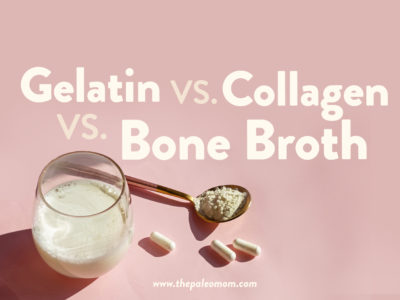Have I mentioned lately how much I love bone broth? There’s a reason it’s been prized across numerous cultures and traditional societies, and not just because it’s so delicious! Bones (and the broth made from them) contain several health-promoting nutrients hard to get elsewhere, making it a valuable addition to our diets. Let’s take a look at what makes broth such a special, healing food!
What is Broth?
Bone broth is the liquid made from boiling bones in water. Virtually any animal bones can be used: turkey, chicken, beef, bison, lamb, and even fish bones all create flavorful, nutritious broth! Typically, the bones will have some connective tissue, like joints and tendons, and some meat attached. There are a number of different cooking techniques (for instance, this is how I make chicken broth), but in general, bones are boiled for anywhere from a few hours to 40 hours (or more!) to liberate their nutrients and create a yummy liquid.
In contrast, meat broth is cooked for a much shorter period of time (1 to a few hours) from very meaty bones (like a whole chicken). While meat broth certainly has some health benefits, it has a lower nutrient content of a long-cooked bone broth.
What’s the difference between broth and stock? Stock is meat broth or bone broth that has veggies and/or herbs added for additional flavor (and nutrients!). In the Paleo community, we tend to simply use the term bone broth to refer to either bone broth or stock made from bone broth—I think because we like to emphasize our nutrient-focus in this community as well as the fact that we just cooked something for two days straight! Hey, that deserves some credit!
The Nutritional Goodness of Broth
From a nutritional standpoint, broth offers two important things: minerals and amino acids (the building blocks of protein, used in every cell in our bodies)!
Keep in mind, the nutrient profile of bone broth is highly variable and depends on the type of bones used, how long they’re cooked, how disintegrated they become, and what other ingredients are added (like vegetables and herbs, which contain their own vitamins and minerals that can seep into the broth water). So, it’s hard to pin down exact nutrient values that will be consistent for every batch of broth we cook up.
But, enough analyses have been performed on broth to give us a ballpark idea of what it contains! A recent test performed by Covance Laboratories in Wisconsin (using long-cooked bones from organically raised chickens, as well as vegetables added during the cooking process) found that 8 oz. of broth contained the following:
Minerals
- Calcium: 6.14 mg
- Copper: <0.0298 mg
- Iron: <0.119 mg
- Magnesium: 52 mg
- Manganese: 0.024 mg
- Phosphorus: 19.5 mg
- Potassium: 94.3 mg
- Sodium: 57.5 mg
- Zinc: 0.0517 mg
(Another analysis from way back in 1934, using chopped veal bones simmered in water (and a little vinegar) for 4 to 9 hours, showed similar mineral values.)
Amino Acids
- Aspartic acid: 553.3 mg
- Threonine: 214 mg
- Serine: 242.67 mg
- Glutamic acid: 1013.33 mg
- Proline: 986.67 mg
- Glycine: 1773.33 mg
- Alanine: 773.33 mg
- Valine: 181 mg
- Isoleucine: 131.67 mg
- Leucine: 276.33 mg
- Tyrosine: 76.33 mg
- Phenylalaline: 192.33 mg
- Lysine: 303 mg
- Histidine: 93.67 mg
- Arginine: 696.67 mg
- Cystine: <24.03 mg
- Methionine: 96.33 mg
Nutrivore Weekly Serving Matrix
An easy-to-use and flexible weekly checklist
to help you maximize nutrient-density.
The Weekly Serving Matrix is very helpful! I’ve been eating along these lines but this really helps me know where to focus vs. which foods serve a more secondary role. It’s super helpful and has taken a lot of worry out of my meal planning. Thanks!
Jan
That might look like a long list, but really, just a few key nutrients are behind broth’s main benefits! Along with containing small amounts of important minerals (including electrolytes) to help support various biological processes and skeletal health, broth is rich in two very valuable amino acids that tend to be underrepresented in most diets: glycine and proline. Both of these amino acids are found in connective tissue (the biological “glue” that holds our bodies together) and play major roles in healing. But, each amino acid also supports some unique individual functions! And even though they’re technically non-essential (meaning our bodies can produce them if we don’t get enough from our diets), consuming glycine and proline from food is much more efficient than manufacturing them internally, and helps ensure we get their maximum health benefits!
Glycine: Glycine is the smallest amino acid, but that doesn’t mean it’s not important! Along with being required for synthesizing DNA, RNA, and numerous proteins in the body (which makes it critical for digestive health, nervous system health, and wound healing), glycine is converted into the neurotransmitter serine—which improves memory, alertness, mood, and relaxation. And, in the brain, glycine produces a calming effect by inhibiting excitatory neurotransmitters. In other words, this is a great amino acid for helping you feel good and think optimally!
Glycine also plays a role in blood sugar regulation by helping control gluconeogenesis (the manufacturing of glucose in the liver), and enhances muscle repair and growth by regulating the secretion of human growth hormone (HGH) and increasing creatine levels.
And in case all that isn’t enough, glycine is an amazing helper for detoxification (it’s required to produce the “master antioxidant” glutathione) and digestion (it regulates the synthesis of bile salts and the release of gastric acid). Whew! And the best part? Bone broth is one of the very best sources of glycine, since this amino acid is richest in connective tissue.
Proline: Proline is also an amazing amino acid that can actually benefit our hearts. It allows blood vessel walls to release buildups of cholesterol back into the bloodstream, which shrinks the size of potential blockages (and reduces the risk of coronary events). Like glycine, it’s involved in collagen formation, and it also helps the body break down proteins for use in healthy cells.
Even though proline is officially classified as non-essential, some research shows that when people are placed on a proline-free diet, their plasma proline levels fall by 20 to 30 percent—suggesting that our bodies might not be able to produce as much as we need. It would be a huge bummer to get short-changed on such an amazing amino acid, so dietary sources really are vital. Once again, it’s broth to the rescue!
What About Calcium?
A quick (but important!) note on calcium. Although rumors abound that bone broth has as much calcium as milk, this actually isn’t true. Multiple analyses of broth from different sources show that one serving (8 oz.) contains less than 10 mg of calcium, compared to about 300 mg for the same amount of cow milk. (The low level of calcium in broth holds true even during longer cooking times (24 hours) and when vinegar is added during cooking, which is sometimes advocated as a way to increase calcium extraction. Studies show that the addition of vinegar, even in larger amounts than typically used when making broth, doesn’t have a significant effect on how much calcium is pulled out of the bones! This might be due to the collagen and other protective colloids encasing bone, which could act as a buffer against acids.)
But, that doesn’t mean broth isn’t still helpful for our bones! It does contain some magnesium, phosphorus, and copper, which also support skeletal health (among many other things).
Drink Up!
Bone broth has another merit worthy of note: It allows us to glean nutritional benefits from a part of the animal that might otherwise be wasted. Environmental sustainability and ethical treatment of animals are important concepts in the Paleo community, two of several reasons for the emphasis on grass-fed and pasture-raised animals as well as eating “snout to tail”. (The other reasons are derived from the better nutrient profile of grass-fed and pasture-raised animals and the supreme nutrient-density of offal.) Whether we use it as a base for soups, a flavor booster in recipes, or just drink a warm cup on its own, bone broth is a fantastic addition to a nutrient-dense diet to keep our bodies healthy and our bellies happy!
Want a shelf-stable, ready made broth for when you simply don’t have time to make your own? My favorite is Kettle & Fire.
Citations
“DL-Proline: Compound Summary.” National Center for Biotechnology Information. PubChem Compound Database. Accessed April 20, 2016.
Jaksic T, et al. “Plasma proline kinetics and concentrations in young men in response to dietary proline deprivation.” Am J Clin Nutr. 1990 Aug;52(2):307-12.
McCance RA, et al. “Bone and vegetable broth.” Arch Dis Child. 1934 Aug; 9(52): 251–258.
Prudden JF & Balassa LL. “The biological activity of bovine cartilage preparations. Clinical demonstration of their potent anti-inflammatory capacity with supplementary notes on certain relevant fundamental supportive studies.” Semin Arthritis Rheum. 1974 Summer;3(4):287-321.
Rosen HN, et al. “Chicken soup revisited: calcium content of soup increases with duration of cooking.” Calcif Tissue Int. 1994 Jun;54(6):486-8.
Schuette K. “Stock vs. Broth: Are You Confused?” Biodynamic Wellness.
Schwick HG & Heide K. “Immunochemistry and immunology of collagen and gelatin.” Bibl Haematol. 1969;33:111-25.











